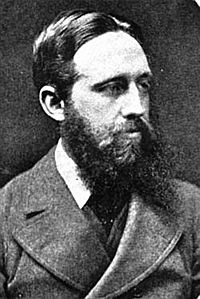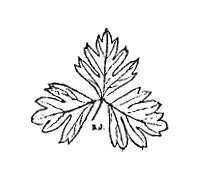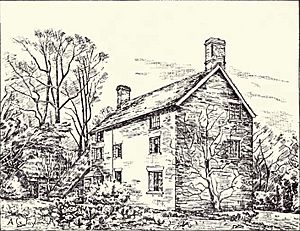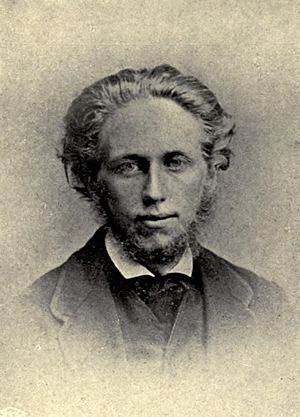Richard Jefferies facts for kids
Quick facts for kids
Richard Jefferies
|
|
|---|---|

Richard Jefferies
|
|
| Born | 6 November 1848 Coate, Swindon, Wiltshire, England |
| Died | 14 August 1887 (aged 38) Goring-by-Sea, Worthing, Sussex, England |
| Occupation | Writer (novel) |
| Nationality | English |
| Period | 19th century |
| Genre | Children's literature |
John Richard Jefferies (born November 6, 1848 – died August 14, 1887) was an English writer. He was famous for writing about nature and country life in England. His childhood on a small farm in Wiltshire greatly shaped his stories. This farm life became the setting for many of his important books.
Jefferies wrote many different types of books. These include Bevis (1882), a well-loved children's book, and After London (1885), an early science fiction story. For much of his adult life, he faced a serious illness called tuberculosis. His struggles with this illness and with money also influenced his writing. Jefferies deeply felt and thought about the world around him. He wrote about these feelings in The Story of My Heart (1883). This book, which explored his inner thoughts, made people see him as a nature mystic. However, most people admire him for how well he showed his love for nature and people in his stories. His essay collections, like The Amateur Poacher (1879) and Round About a Great Estate (1880), are also very popular. The writer Walter Besant once said after reading Jefferies: "We must have been blind all our lives; here were the most wonderful things possible going on under our very noses, but we saw them not."
Contents
Life and Writing Adventures
Growing Up in the Countryside
John Richard Jefferies was born at Coate, near Swindon, in Wiltshire. His father, James Luckett Jefferies, was a farmer. Richard's birthplace is now a museum that you can visit. His grandfather, John Jefferies, was a printer in London before running the family mill and bakery. Richard's mother, Elizabeth Gyde, was known as Betsy.
Richard's family life often appeared in his books. For example, in his novel Amaryllis at the Fair (1887), the characters are like his own family. His father, James, loved his garden, much like a character named Iden in Amaryllis. The garden was a special place, remembered fondly in Wood Magic and Amaryllis. His mother, Betsy, was a "town-bred woman" who found country life difficult. The farm was quite small, only about 39 acres (160,000 m2) (15.8 hectares). Later, the family faced money problems and lost the farm in 1877.
Richard spent some of his early years, from age four to nine, with his aunt and uncle in Sydenham. He went to a private school there. But he always returned to Coate for holidays. At Coate, he spent most of his time exploring the countryside. Many of the adventures of his character Bevis were based on Richard's own childhood.
Early Adventures and Becoming a Writer
Richard's father taught him to shoot when he was eight. By nine, he had already shot a rabbit! He spent a lot of time hunting and fishing. Like Bevis, he also built his own boat to sail on the reservoir. He even made his own canoe, just like the hero in After London. Richard was also a keen reader. He loved books like Homer's Odyssey and Don Quixote.
In November 1864, when he was sixteen, Richard and his cousin, James Cox, tried to run away to France. They wanted to walk all the way to Russia! But their school French wasn't good enough, so they came back. Then they tried to go to America, but they ran out of money for food.
Richard left school at fifteen. He continued to wander alone in the countryside. He didn't care much about his clothes or hair. People in Swindon found him a bit strange, but he didn't mind. He didn't help much on the farm, except for chopping wood. Local landowners were suspicious of him because he always carried a gun.
In 1866, he started working as a newspaper reporter for the North Wiltshire Herald. He also wrote for other local papers. The editor of the Swindon Advertiser, William Morris, helped him by lending him books and encouraging his writing. Richard became interested in local history. He wrote articles about it and even found a stone circle near Coate Farm. He also spent a lot of time on the downs, especially at Liddington Castle. There, he would lie on the grass, feeling a deep connection with nature.
In 1867 and 1868, he became very ill. These were the first signs of the tuberculosis that would later take his life. The illness made him very weak and thin. He decided to try to look more "stylish" in the future.
He worked hard to become a writer. He wrote a history of a local family and a guide for new writers. His early novels didn't find publishers. However, he gained national attention in 1872 for letters he wrote to The Times newspaper about farm workers in Wiltshire.
In 1874, he published his first novel, The Scarlet Shawl. That same year, he married Jessie Baden, a farmer's daughter. They moved to Swindon in 1875, and their first child, Richard Harold Jefferies, was born there.
Becoming a Successful Writer
In 1877, Richard, Jessie, and their baby son Harold moved to Tolworth, near Surbiton, close to London. This area was still quite rural back then. Richard spent a lot of time walking in the nearby countryside. These walks later gave him ideas for his book Nature Near London (1883).

The years in Surbiton were very important for Jefferies. His daughter, Jessie (known as Phyllis), was born in 1880. And finally, Richard started to become famous. His new home helped him become known as a "country writer." He wrote many articles about his experiences in Wiltshire for The Pall Mall Gazette. These articles were then collected into books.
His first successful book was The Gamekeeper at Home (1878). It was very popular, and people compared him to the famous nature writer Gilbert White. Three more collections of essays followed: Wild Life in a Southern County and The Amateur Poacher (both 1879), and Round About a Great Estate (1880). Another collection, Hodge and his Masters (1880), was also published. Richard's writing skills grew quickly during these years. The Amateur Poacher is seen as a big step forward, as it was one of the first times he wrote about his own life.
The Bevis Stories
Two of his books from these years tell a connected story. Wood Magic: A Fable (1881) introduces his young hero, Bevis. Bevis is a small child living on a farm near a lake, which is clearly based on Coate Farm and Coate Reservoir. Bevis explores the garden and nearby fields. He meets birds and animals who can talk to him, and even parts of nature like the stream and the wind. The book shows a child's connection with nature. It also tells a story about animals rebelling against a mean magpie.
In Bevis (1882), the boy is older. The talking animals are gone, and the story is more realistic. It describes the adventures of Bevis and his friend Mark. They fight pretend battles with other children, build a boat to sail to an island on the lake (which they call "The New Sea"), go fishing, and even shoot with a homemade gun.
Later Life and After London
In December 1881, Jefferies's illness became more serious. After some painful operations, he moved to West Brighton to get better. Around this time, he wrote his amazing autobiography, The Story of My Heart (1883). He had been planning this book for seventeen years. He said it was "absolutely and unflinchingly true." It wasn't about the events of his life, but about his deepest thoughts and feelings.
His third child, Richard Oliver Launcelot Jefferies, was born in Brighton in 1883. Sadly, this child died suddenly in 1885 from meningitis. Richard Jefferies was so sad that he could not go to the funeral.
Jefferies's next novel, After London (1885), is an early example of "post-apocalyptic fiction." In this story, a sudden disaster has emptied England of most people. The countryside returns to nature, and the few survivors live a simple, almost medieval life.
The book has two parts. The first part, "The Relapse into Barbarism," describes how civilization fell apart. It beautifully shows nature taking back England: fields becoming forests, farm animals running wild, and towns becoming overgrown. London turns into a poisonous swamp. The second part, "Wild England," is an adventure story set many years later in this wild new world. This book was a big influence on other writers, like William Morris and M.P. Shiel.
Final Years and Legacy
After moving several times due to his illness, Jefferies settled in Crowborough. There, he finished his unique novel, Amaryllis at the Fair (1887). This book was based on his own family at Coate Farm. It shows a family and farm slowly heading towards trouble.
Because of his illness, Jefferies couldn't work as much, and he became poor. Friends helped him get a grant of one hundred pounds from the Royal Literary Fund. This help allowed him to move closer to the sea, to Goring-by-Sea. There, on August 14, 1887, he died from tuberculosis and exhaustion. He is buried in Broadwater and Worthing Cemetery.
After he died, many of his articles and essays from newspapers and magazines were collected and published as books. His widow edited the first of these, Field and Hedgerow (1889). Even today, new collections of his writings are still being found and published.
Richard Jefferies's Influence
Richard Jefferies's writings have inspired many other authors. Henry Williamson was one writer who was greatly influenced by Jefferies. He even edited a collection of Jefferies's works. Other writers who admired Jefferies include Edward Thomas, John Fowles, and Henry Miller.
The Richard Jefferies Bird Sanctuary in Surbiton is named in his honor.
Some of Richard Jefferies's Books
Here are some of the books Richard Jefferies published during his lifetime:
- The Scarlet Shawl (1874)
- The Gamekeeper at Home (1878)
- The Amateur Poacher (1879)
- Wood Magic (1881)
- Bevis: the Story of a Boy (1882)
- Nature Near London (1883)
- The Story of My Heart: An Autobiography (1883)
- After London; Or, Wild England (1885)
- Amaryllis at the Fair (1887)
Images for kids
-
Monument to Richard Jefferies in Salisbury Cathedral




